Driving into the quiet town of Washington, Virginia at the foothills of the Blue Ridge Mountains, is a transporting experience. The town of Little Washington is small—blink and you’re sure to miss it—but its charm is consuming. Bright-eyed people duck in and out of quaint looking shops that line Main Street. There’s a wine and chocolate shop. And a bakery. And an art gallery. And for a moment you feel you’ve pierced a bubble into an alternate reality where the outside world ceases to exist. This town is built to feel controlled; and at the center of it all is the famous inn that for over forty years has served as a testament to what can be achieved even in the most unlikely of places.
The Inn at Little Washington was opened in 1978 by Chef Patrick O’Connell and his partner Reinhardt Lynch, turning the seedlings of an audacious vision into the fruit-bearing reality The Inn exists in today. The Inn is a converted car repair garage and gas station that Chef O’Connell and company have managed to turn into one of the most revered restaurants and inns in the entire United States: a five-star hotel and a three-star Michelin restaurant. And in doing so, the group behind this endeavor have managed to transform this sleepy town into an engine that runs on the good fortune of its mainstay. For all intents and purposes, the community of Little Washington is The Inn and The Inn is Little Washington.
And behind it is the man who loomed larger than life my entire time spent in the township. Every person we had the good fortune of having an interaction with had some story to tell about Chef, as they admiringly referred to him as. The tales were spun about his good nature, his affability, his creativity, his process, whipping up the expectation that we were in for a treat that night when we finally got to dine at his acclaimed restaurant.
Early in the day, we poked our heads into The Inn to snoop around. The staff was hard at work, walking with buzzing purpose and attending to the affairs needed to prepare for the onslaught of guests that were to arrive for dinner service later that evening. We were assured it would be okay for us to walk around through the space for a few minutes. There’s something strange about getting to see a stage before it has a chance to transform. It’s empty and it’s quiet and the only thing you can think about is stepping carefully as to not disturb its slumber.
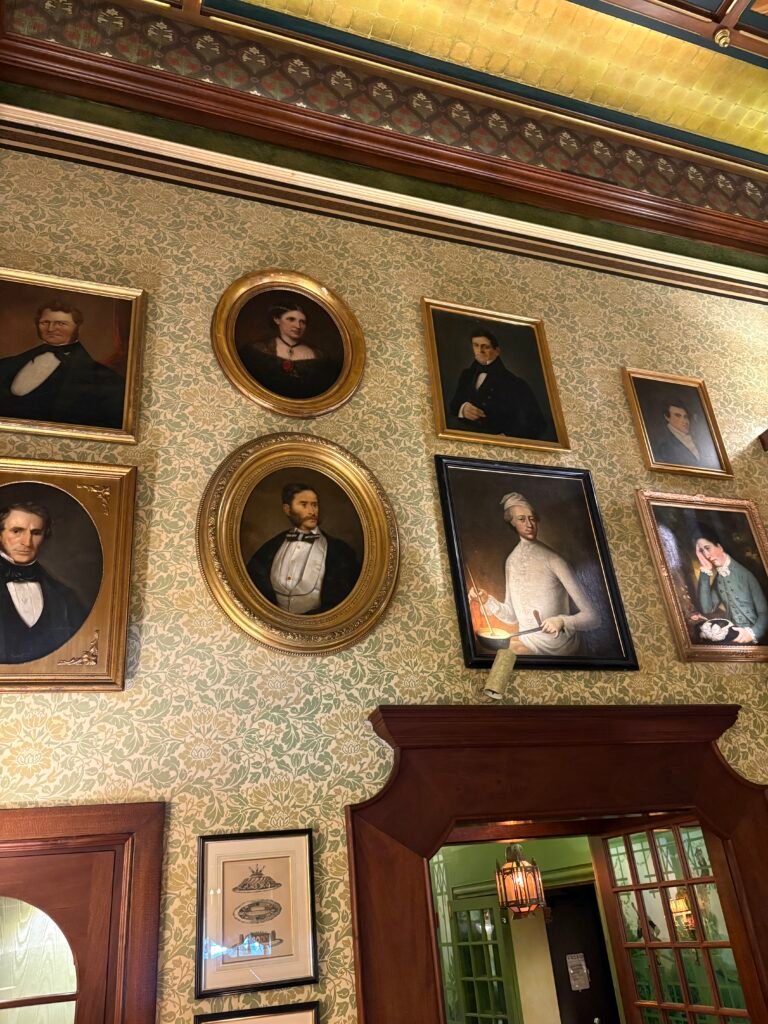
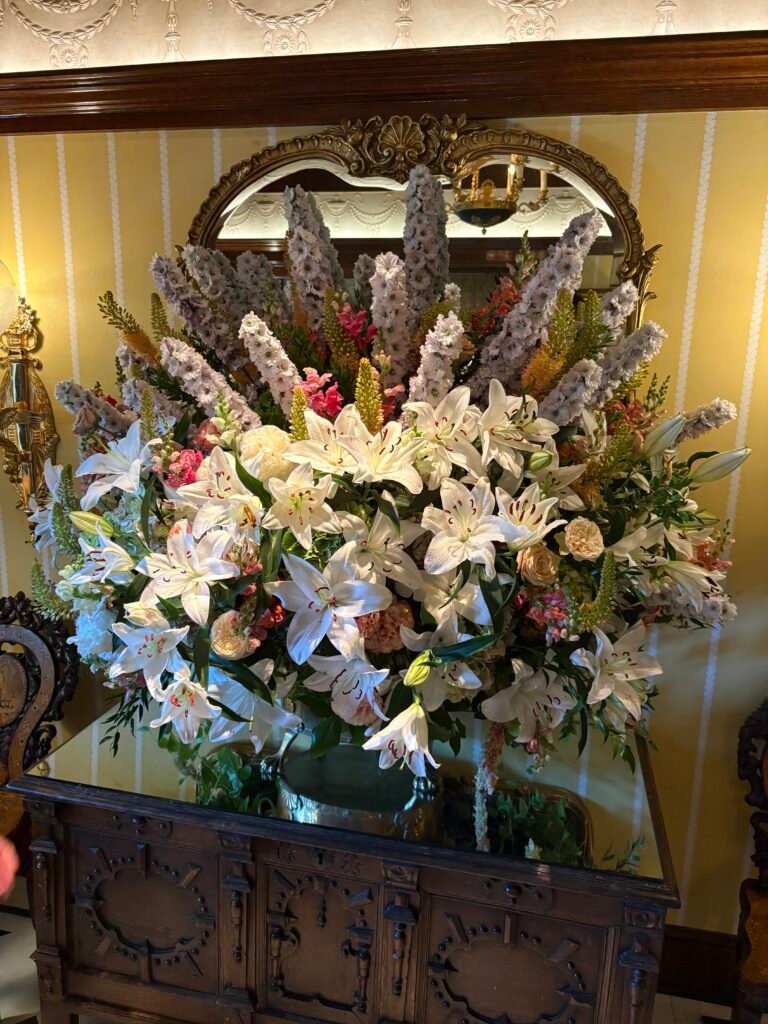
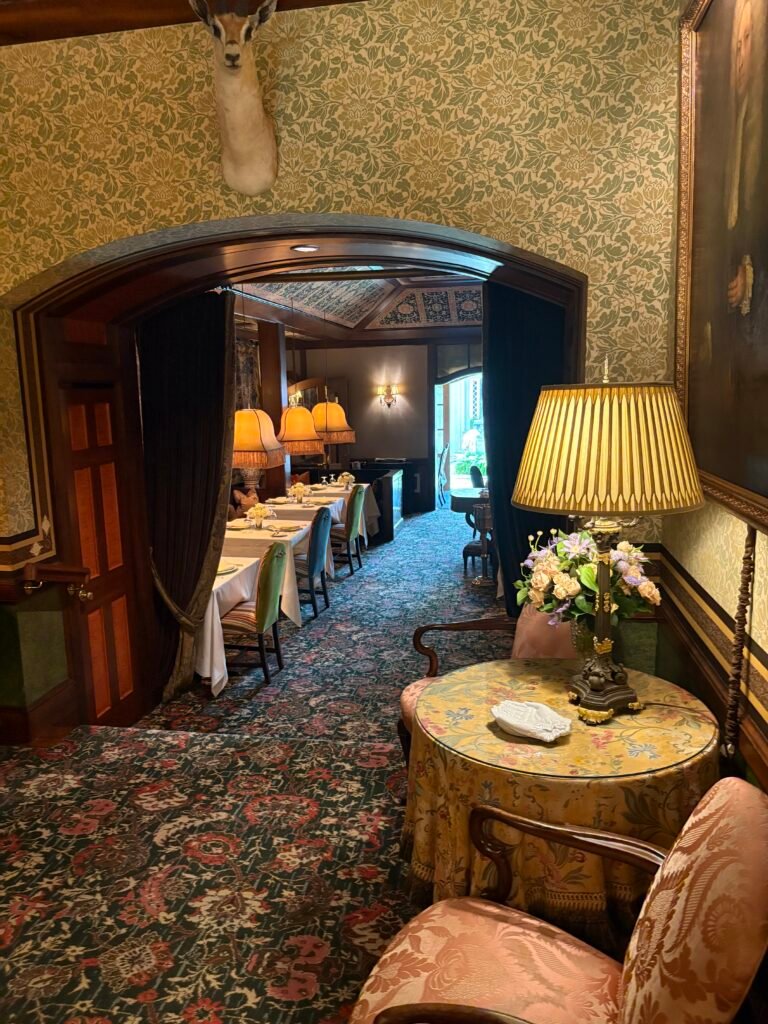
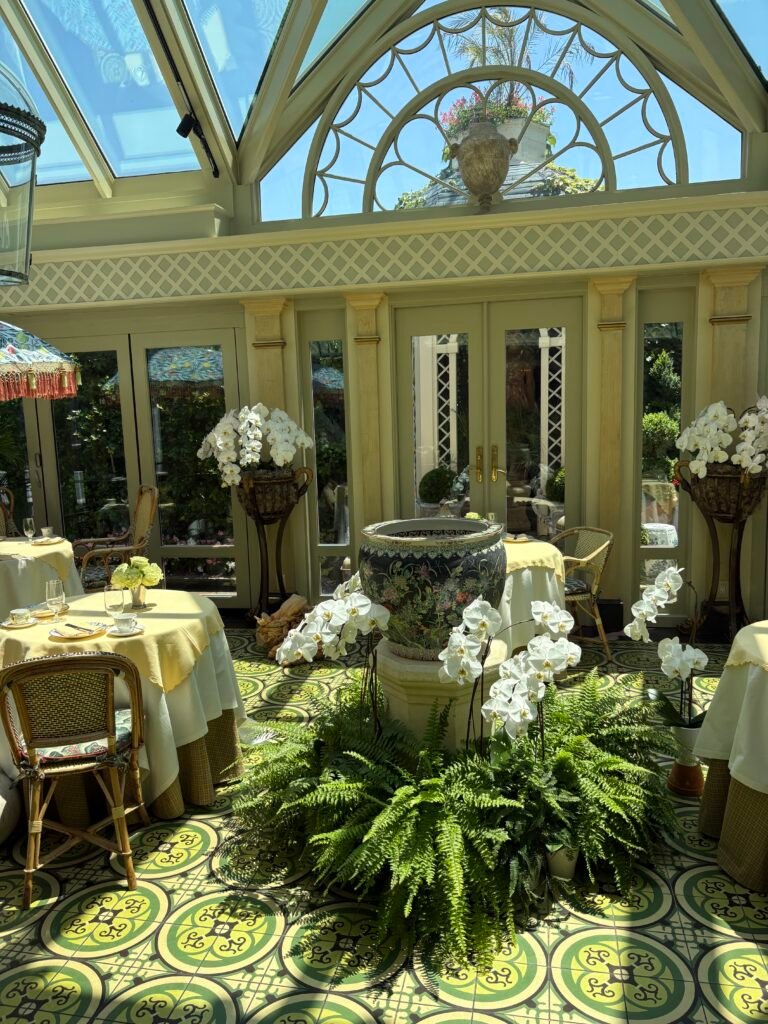
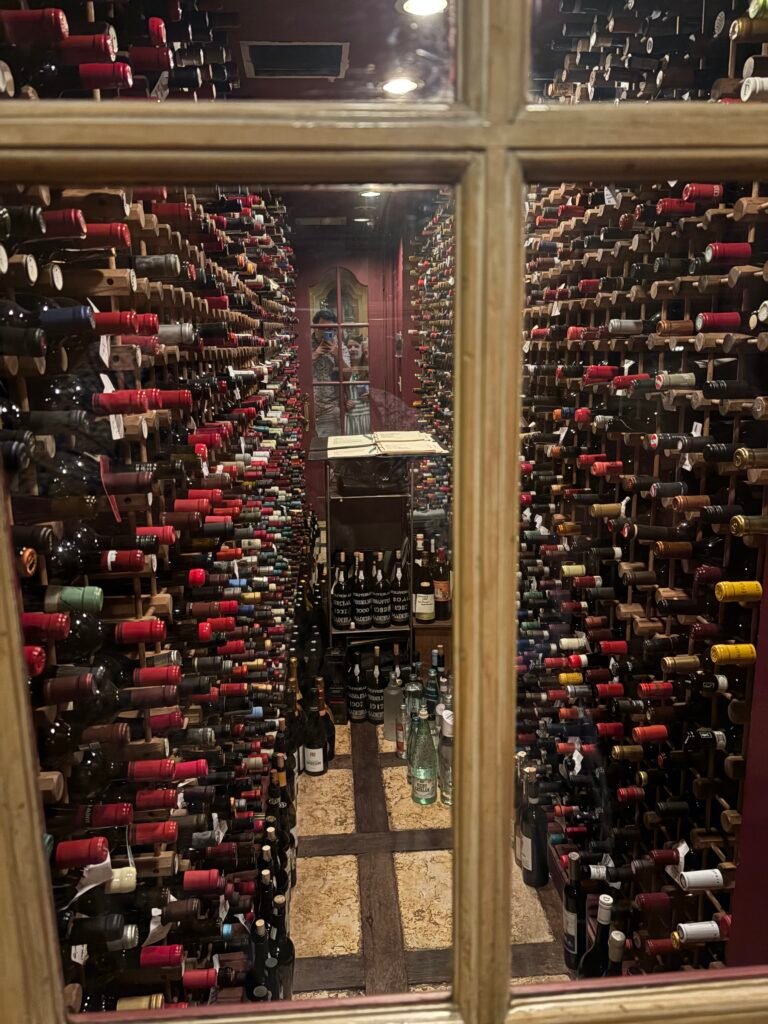
But the beauty of the various dining rooms, and the bar room, and the tea room cannot be understated, looking both meticulously thought out and chaotically asunder. It evoked a temporal experience of walking through a small corner of Versailles mixed with the pleasure dens of ancient China and the tobacco parlors of colonial Americana. Every inch of the space was covered with something new and exciting, and I could have spent hours toiling around looking for new pockets of intrigue. But at some point you feel you’ve overstayed your welcome and should leave well enough alone.
Later in the day we arrive back for our reservation to find a restaurant transformed. Guests fill the seats and the rooms have become something new: the show has begun and the buzzing performances of the wait staff dance around the space, elegantly coordinated to the heartbeat of the kitchen. We were led to our table; a beautiful corner giving a wonderful vantage point to see into the greenhouse and out into the Koi fish garden. Our seats were a plush bench with lavish throw pillows that one could sink into with calming assurance. Maybe a tad impractical for an entire meal, but it felt like a lap of luxury compared to other offerings in the restaurant, so I felt enamored with our draw.
Several times throughout this review I will be singing the praises of our head waiter, Gerson. His service was impeccable, and he made us feel welcomed and accommodated. And he cleaned up some of the messes that we’ll get to shortly.
The meal began with Gerson explaining the choice ahead of us: The Inn was offering three menus that night—a vegetarian offering, a classic menu filled with some of Chef O’Connell’s most famous dishes, and a modern version with some newer offerings. We were not all that interested in the vegetarian menu (being avid meat eaters certainly predetermined that for us), and the modern menu sounded like it featured less hits pound for pound. I’m sure the modern menu is great, but the value proposition of the caviar dish was too strong a draw for myself and the rest of my dinner companions (who I will introduce as my mother and my sister; the latter of which had never been to a Michelin star restaurant before this night; I know, what a way to get the hooks in!).
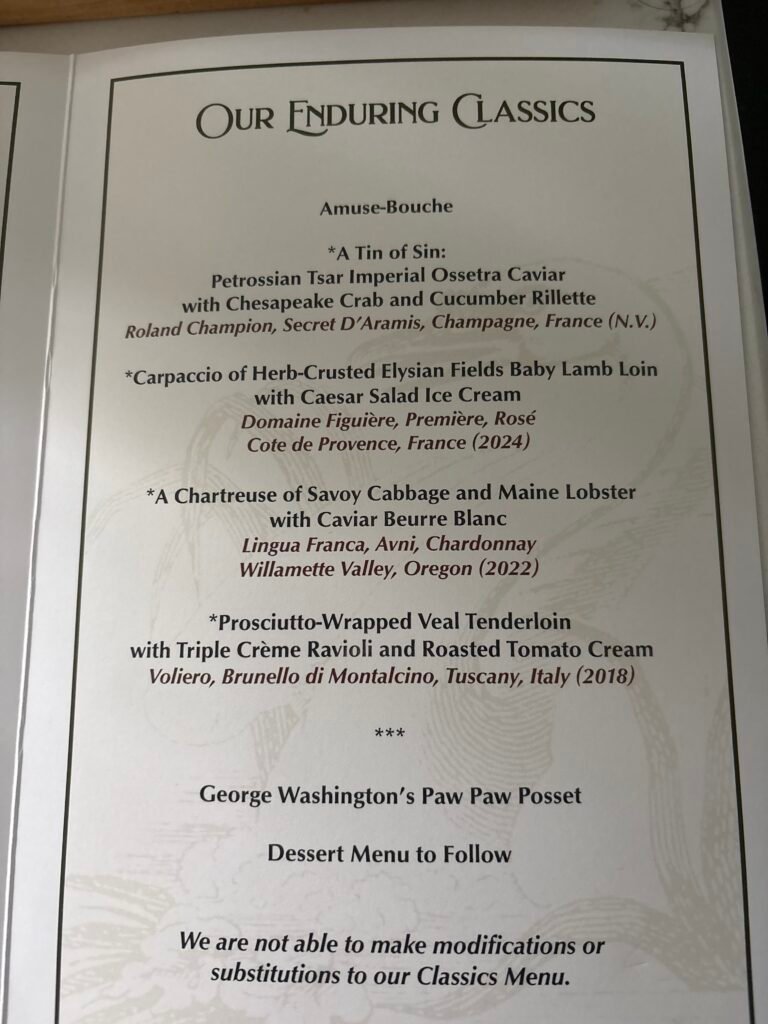
It’s at this point that I should mention the first slip up of the night. Probably more accurately it was a slip up that happened prior to my arrival in Little Washington. We were each presented with the menu which included a message of warm welcome to the three of us, called out by first name. The only problem was my name was not spelled correctly. I do not have a particularly difficult first name to spell. In fact, it’s a shorter version of my Christian name, and a common one at that. I did mention it to Gerson. And Gerson took care of it. By the end of the meal, the menus were presented back to us with no typographical errors. In retrospect though, maybe it would have been worth keeping a copy of the menu with the misspelling—a keepsake of a great night that can never be fully perfect. I do have a picture of it that I’ll keep in the vault, but that primary source probably found itself in a fire somewhere out back.
With that misstep behind us, it was time to start the main attraction: the food. The first round of amuse bouche—amuse bouches? Amuses bouche?—arrived at our table: a potato chip cannolo filled with pimento cheese and a rice chip with a smear of foie gras and a sliver of some kind of fish. In this duel of chips as it was called, the cannolo reigned supreme. Creamy, oniony, crunchy; it reminded me of a sour cream and onion flavored chip. The other chip was fine. A bit forgettable. And I’m not just saying that because I can’t remember what type of fish it had on top of it.
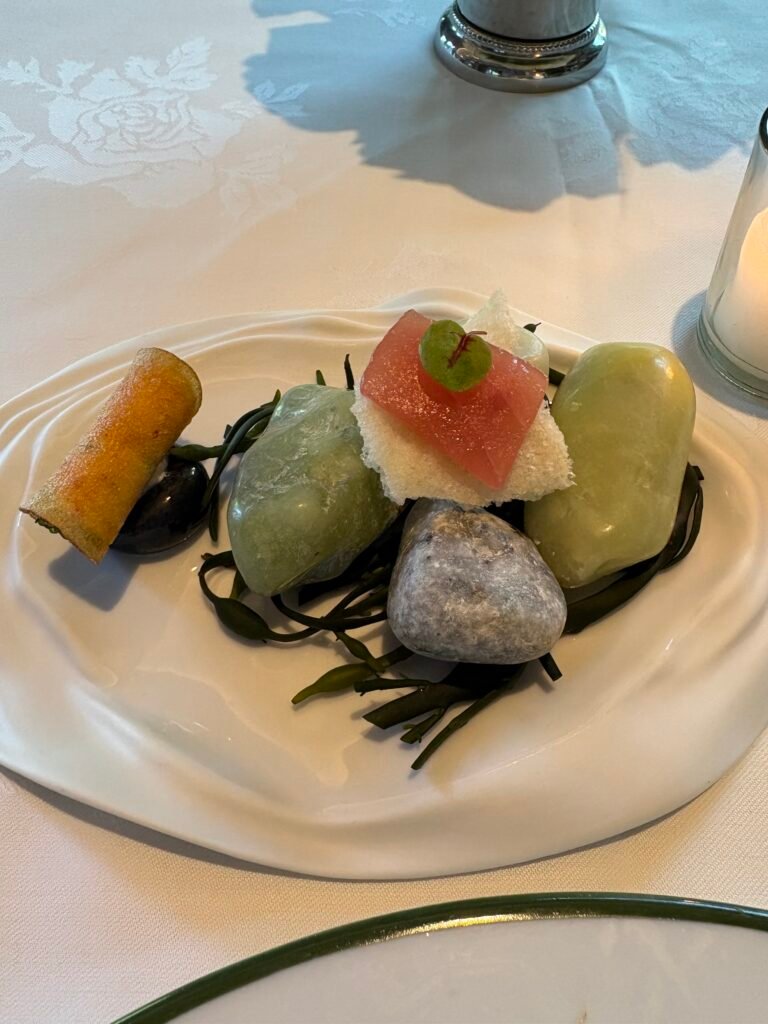
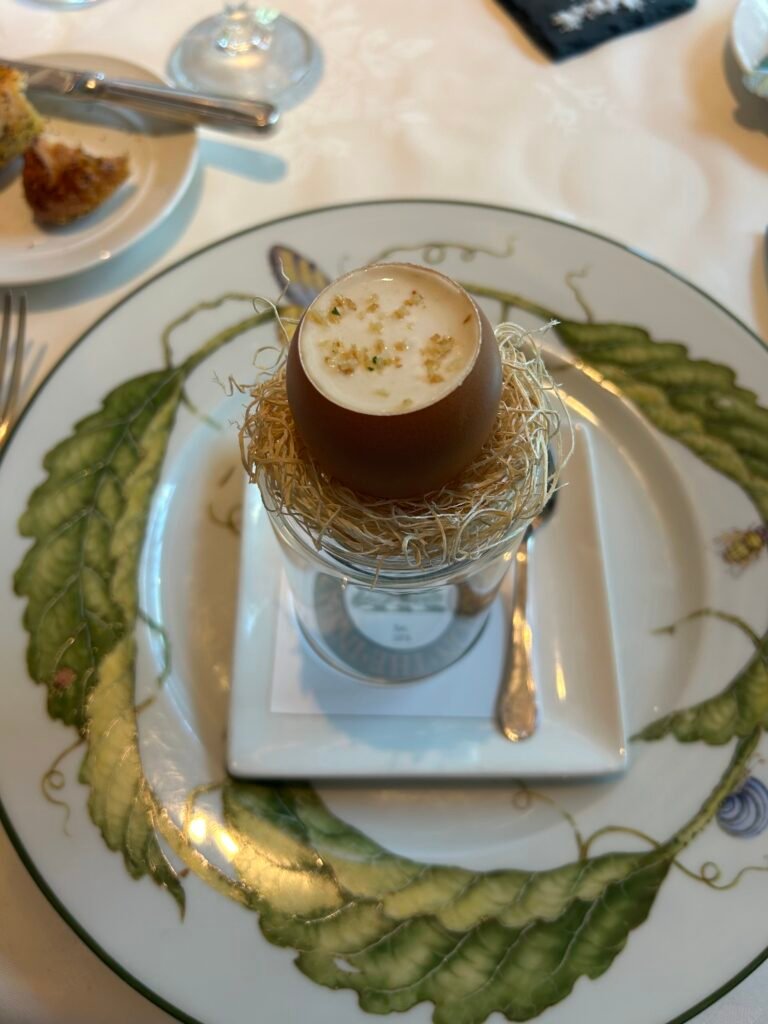
Next up was a beautiful, complicated, layered egg dish, served in the shell of the egg. I lost track of all of the components of the dish, but the main layers were a roasted garlic custard, with parmesan and chopped asparagus, turnips, and breadcrumbs on top. This dish was light and airy. We were instructed to dig down to the bottom and come back up to get an orchestra of flavors; and oh did the symphony ring for us at once. This was a delightful way to fully open the palate for the rest of the meal to come.
Before we get into the main dishes, I think its worth mentioning that at this point we have struck up a solid rapport with Gerson about his aspirations in his career, his background, and some of the Michelin star restaurants we both have been blessed to visit. For example, the staff was sent to Per Se up in New York. I’m extraordinarily jealous of that perk of his job. I’ll note my employer has never once offered to send me to Per Se in New York.
We also talked briefly about the documentary about Chef O’Connell and The Inn at Little Washington (admittedly, we had all missed it before the trip so I got around to watching it before tucking into writing this review) and then we got on to the subject of their famous pawpaw posset dish—an homage to George Washington that was to be featured on the Enduring Classics menu we had ordered. More on this later. It’s just important that I mention now that this conversation occurred with Gerson around this point in the meal.
Throughout the night, Sam the bread expert for the restaurant (this restaurant seemingly has a person for everything. More on that later) would come around with freshly baked bread offerings. The French baguette was unbelievable. It was warm to the touch, fresh out of the oven and coated in toasted sesame seeds. Sam also informed us that he had prepared unsalted butter for the night and slapped a dollop of it on to an onyx marble butter plate with a garnish of coarse salt lining the brim. A smooth touch that added just that extra little bit of weight to his area of expertise. Because we were in tight quarters where we were sitting he would only have room to come around with a tray of bread, but later in the night we witnessed him moving around with a full cart in more open spaces. Believe me when I say: the mound of unsalted butter this man had on his cart could have put the entire township of Little Washington into a coma.
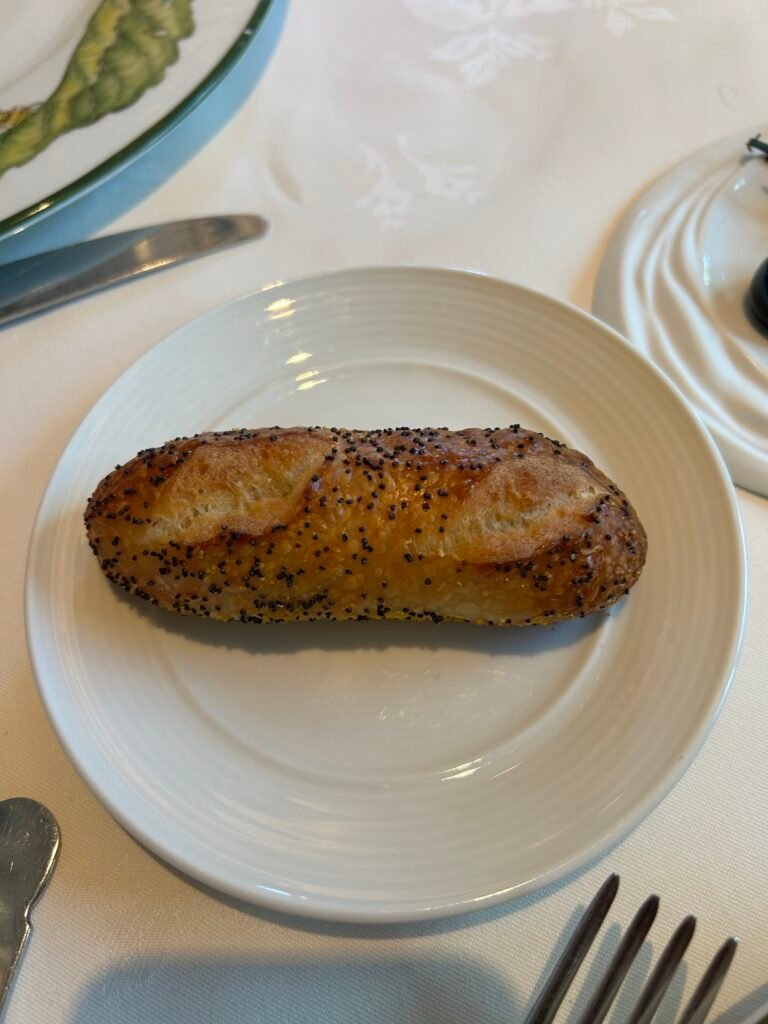
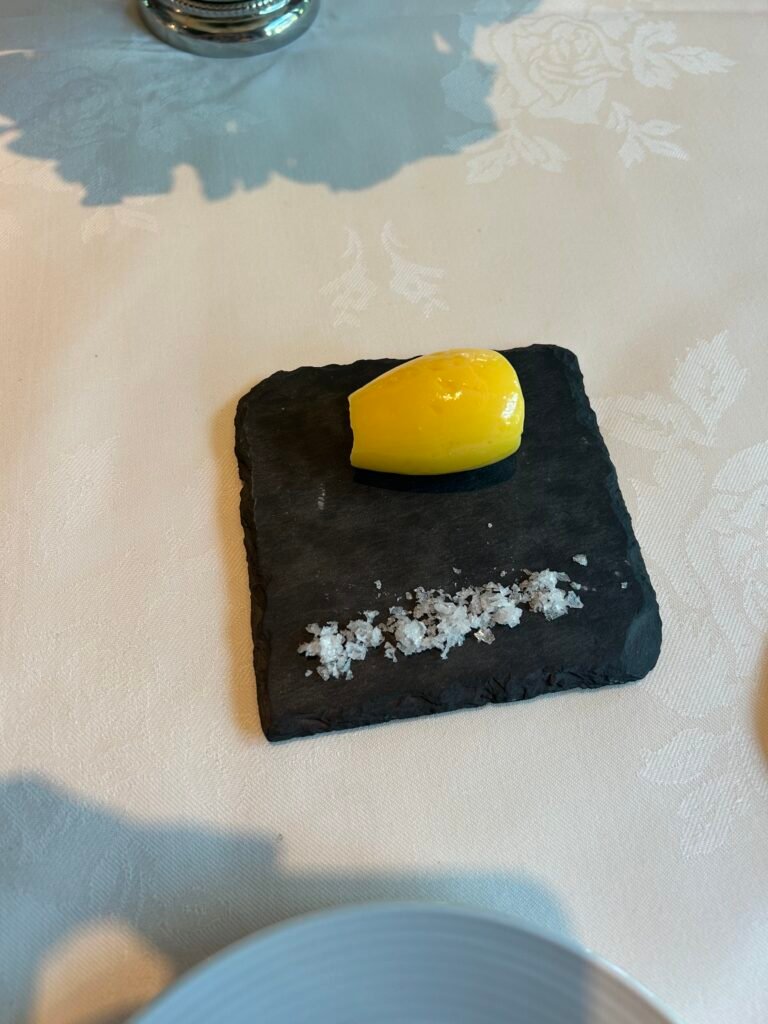
Next up was one of the main attractions of the entire night: the Tin of Sin—a tin of Imperial Ossetra caviar atop a bed of peekytoe crab and cucumber rillette. The main appeal for us was that a week prior this was featured on the menu as a $65 supplement. Now getting to try this dish as an inclusive course felt like a real win. Thank God for the summer solstice bringing in the tidings of a new menu at The Inn. The dish was decent. Imperial Ossetra caviar is nothing to put your nose up to, but caviar atop crab is not necessarily the most inspired offering.
The caviar had a beautiful golden hue and a pleasant salty brine, but its main assignment was adding some heft to the rillette mixture below it. Having had caviar before, at this point I just find it to be luxury for the sake of luxury unless it finds utility in its presence in a dish. On this occasion, the former rings true. My main enjoyment during this course was getting to watch my sister try real caviar for the first time. I think her takeaway was roughly the same, but she hadn’t yet had a chance to have caviar shine as a featured role player of a dish instead of the lights, camera, action star many try to make it out to be. That would change later on in the meal.

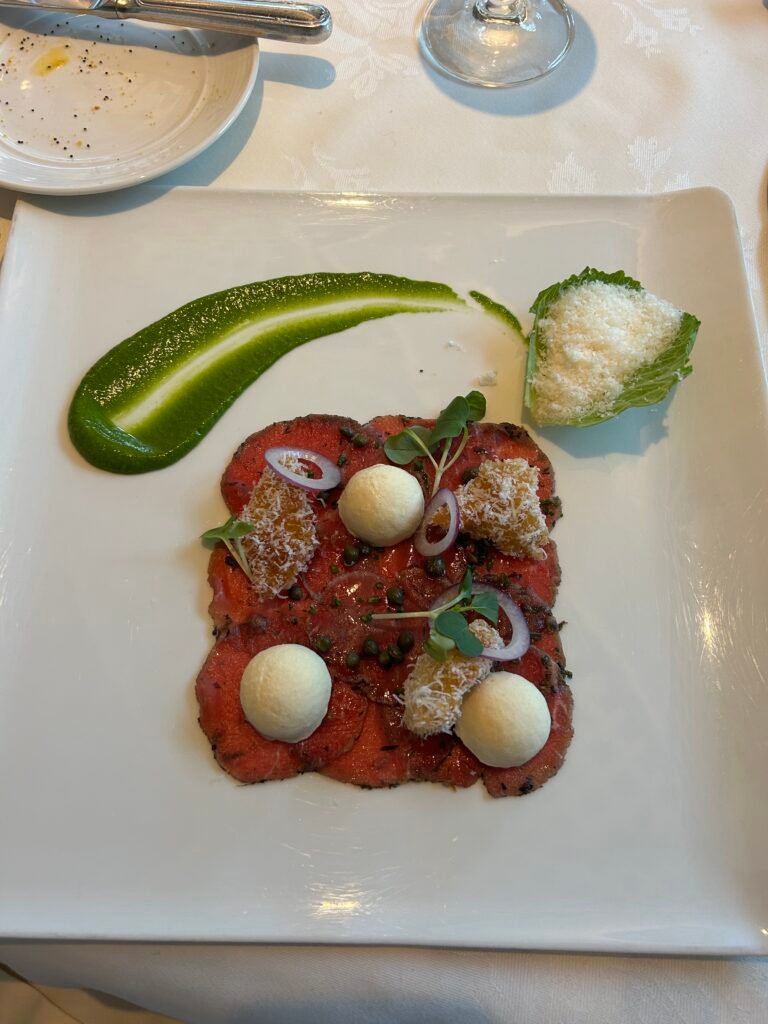
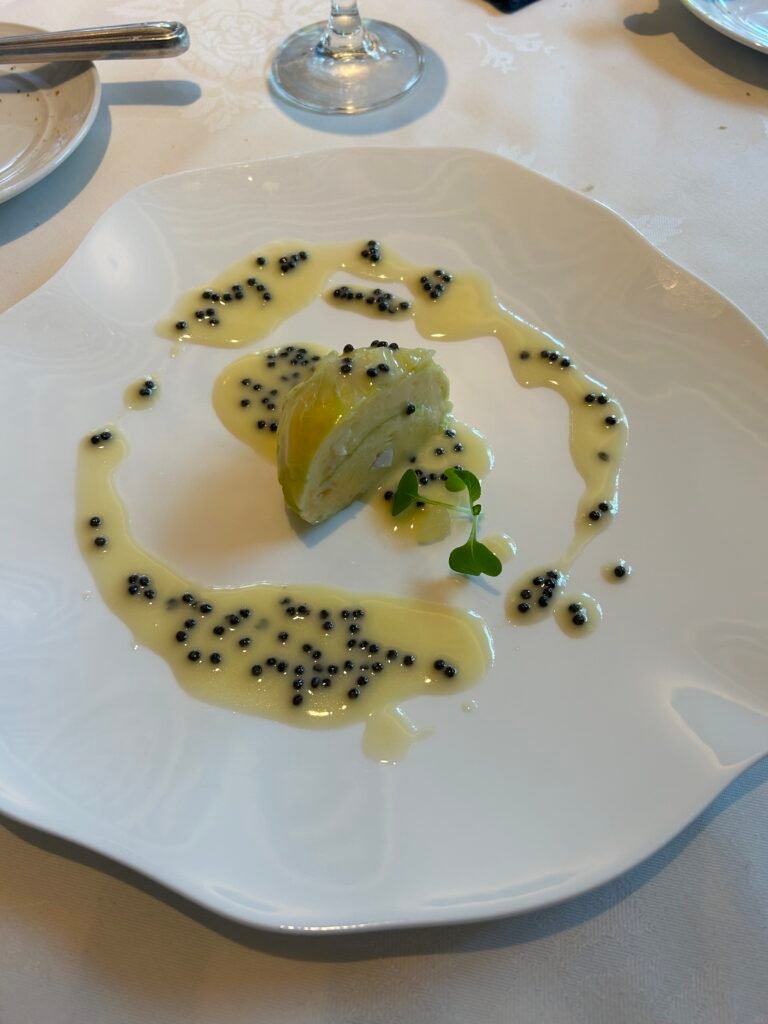
The next course is a staple of Chef O’Connell’s repertoire and embodies his sensibilities of all of his food being “fun loving, elevated”. This is the lamb carpaccio with a deconstructed Caesar salad ice cream. The lamb was sliced thin, beautiful, peppery, succulent. But on top was where the magic really happens. Tiny little dollops of ice cream that tasted exactly like Caesar salad dressing. A pesto smear, craggly homemade croutons, and a shard of lettuce brimming with shaved parmesan complete the dish and allow for a build-your-own experience (or if you’re like my sister you’ll just eat the lettuce and parmesan like a taco like some kind of lunatic). And who can say no to something so inventive. Caesar salad and ice cream are two things I would never in a full lifetime consider putting together and somehow it worked. And somehow it hasn’t left my thoughts ever since that night. I like to cook (I like to eat more), but some people were meant to cook.
A chartreuse of savoy cabbage and lobster were next. Gerson informs us that Chef O’Connell prepares this dish by turning the lobster into a mousse and wrapping it tightly within a softened cabbage wrap. The plate is boring as presented, that is until we see Gerson pull out the connective tissue of the course: a lemon and black caviar beurre blanc that is ladled around and on top of the chartreuse to create a beautifully resonant presentation with contrasting colors of the beurre blanc sauce against the black caviar pearls. Hands down this was the highlight of the night. The cabbage was fork tender without falling apart. The lobster mousse was creamy and evocative and the bounce of the beurre blanc gave the dish a rolling hill shape—layered and complicated and unending.
By this point we’ve been seated for about ninety minutes and everything has been a parade of hits. It’s an enduring onslaught that is really only just beginning. Next up is the last main course of the night: a veal tenderloin wrapped in prosciutto with a tallegio raviolo, served in a tomato cream sauce. This dish was the dish that I think unfortunately breaks the hit streak. It was fine. It tasted fine. Nothing against the taste. It just wasn’t inspiring. And it was hard to gain access to with my knife because of the depth of the bowl and the differing textures of the prosciutto and the veal. I ended up having to hack my way through all the components of the dish first with my knife at an awkward angle before I could switch to my fork and consume it in more manageable bites.
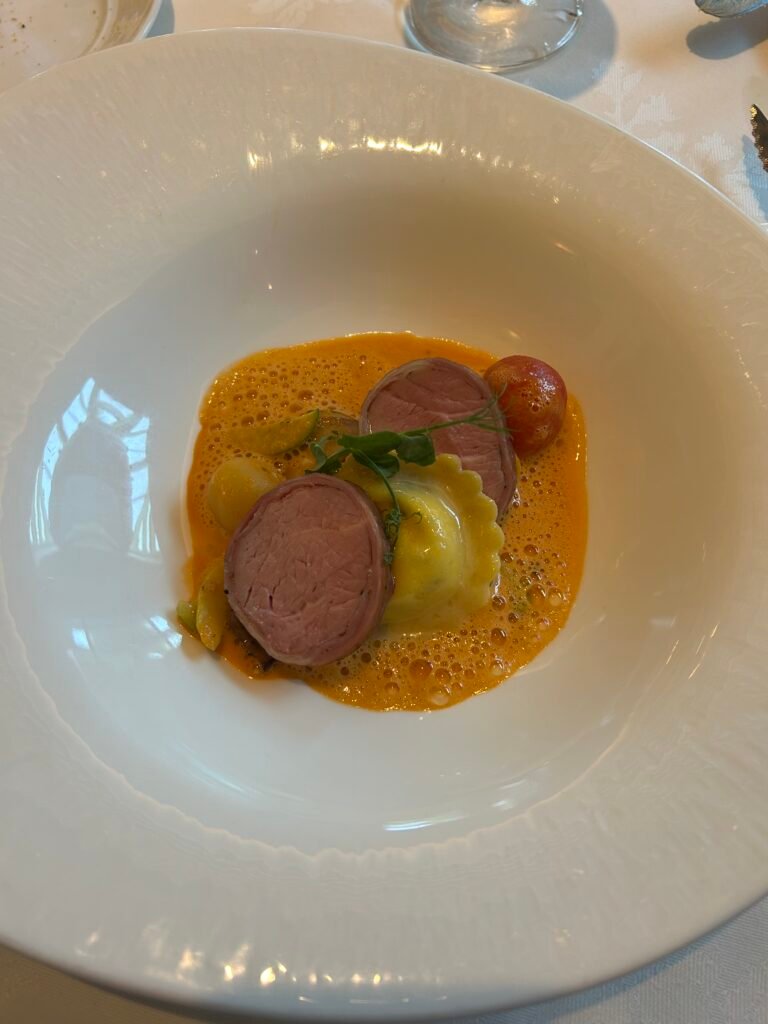

None of the components of the dish seemed to harmonize for me. It felt like the dish was constructed for its presentation over its cohesion of taste. We all noted that the duck three-ways dish off of the Here and Now menu would have been a superior option to sub out, and would have likely made the Enduring Classics menu a perfect menu.
With that lame note of an ending to the main dishes on the Enduring Classics menu, it was time to pivot to dessert and to the end of the meal. Or so we thought. This was the point of the meal where things started to get bumpy.
Gerson came by to give us our dessert menu and talk us through the options. I was unfortunately disappointed to see that the Apparently a Pear option was not available that night. This was a dish I was looking forward to for dessert—a cheesecake shaped and painted to look like a pear. But we can’t always get what we want in life and that’s okay.
For $32 more, there was a cheese supplement. Tale has spread far and wide about the famed cheese cart at The Inn at Little Washington as well as the residential cheese sommelier, Cameron, as it were. What we were really interested in was being able to have our cake and eat it too. This was a point of emphasis for our group for months leading up to the night of the reservation. We wanted both the cheese and the dessert!
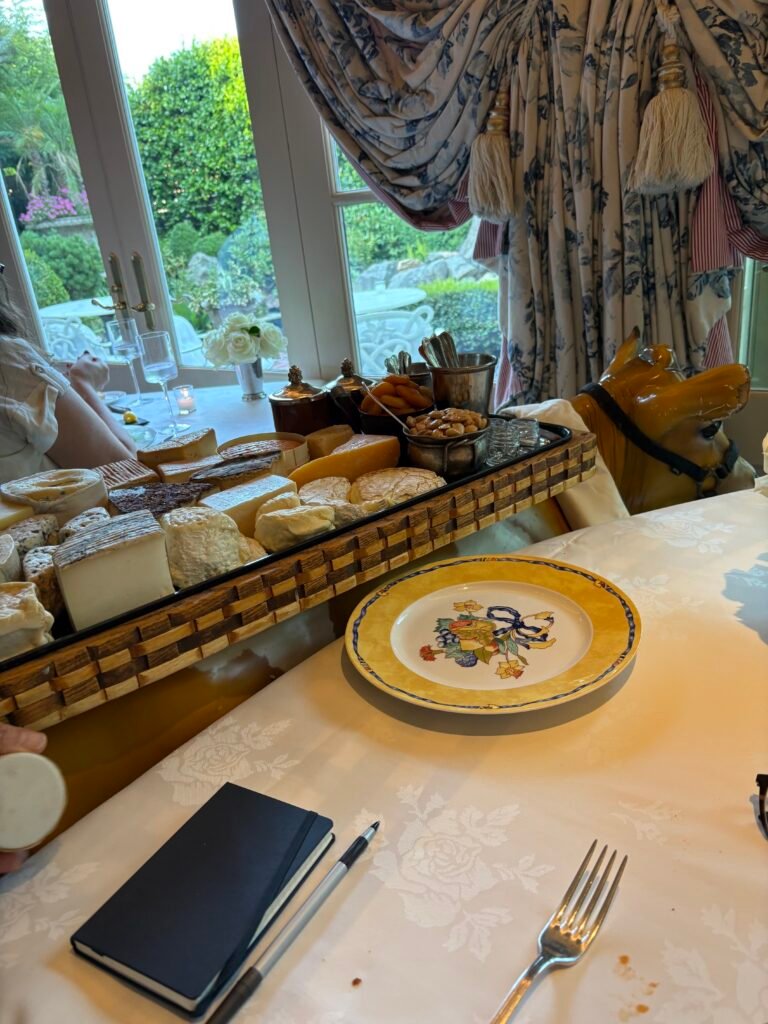
So we assigned roles for this point in the night to humbly ask if it would be okay if we could do both. We ran lines on the drive up, so we were prepared. The gameplan was that my sister (a Michelin star novice) would be the sacrificial lamb to ask such a silly question and to take the brunt of the ridicule when they laughed in her face and told her no. She was prepared for the big moment. She knew that no matter what happened out there, it was all just part of the act. Composure is key! So she stepped up and gave her line, “Is it possible for us to do the cheese supplement AND a dessert?”. Without skipping a beat and maybe even a hint of bemusement, “Yeah of course.” With that tense moment behind us, having gotten exactly what we wanted out of this exchange we all ordered our separate desserts. It would be a while until we saw these dishes. More on that in a bit.
The cheese cart came around a few minutes later. Cameron, who also serves as the certified tea master and water sommelier for the restaurant (a man of many talents) began his show. I will note that in my research I found that Cameron is often struck with cow and dairy puns galore to spice up the cheese cart experience. Unfortunately, on our night he couldn’t have seemed more off; like he was simply going through the motions of it all. I don’t expect anyone to sing and dance for us, and I can’t begin to know where anyone else’s head is at on any given day, but to hear so many people rave about what he brought to the table in his special brand of showmanship and then for us to get a very different and much colder experience was a bit jarring. For what that is worth, I guess.
We received a plate of five different cheeses to share, hand selected by Cameron, as well as an accompaniment of apricots, and toasted almonds, jam and honey. The cheeses were all quite good. The standout for me was a soft blue cheese, but we got a good range of different textures and hardness with our selections. All in all, I was glad we were able to do it, but I was not overly impressed with the paid experience of it.
After the cheese course was finished and cleared away, a curious thing happened: a new dish was placed in front of us by a few members of the wait staff. Gerson was not present to explain the dish, so they told us it was a blackberry and vanilla dreamsicle and then walked away. At this point we didn’t really know what this was about, because we expected the pawpaw posset dish we had chatted with Gerson about earlier. But we ate it because we figured this must be a surprise dish? It was unclear but we didn’t have our menus in front of us to follow along because they were busy being corrected for the typo. Errors compound confusion.
We were pretty dead set on having the pawpaw dish, because of its rarity and because it’s a staple of The Inn. So the next time Gerson was to come around we were going to check in with him. For anyone that cares, the dreamsicle was good—it did its job of cleansing the palate, but we ate it in shame, knowing that likely somehow a mistake was made.
At this point I exited to go on an odyssey to the restroom. Very clean, well maintained. For some reason, the speaker in the bathroom was playing the Julia Child SNL skit where Dan Aykroyd slices his finger open and blood spews everywhere. An interesting choice that I found amusing. At the sink were some prepackaged toothbrushes and Chef O’Connell’s personal favorite cologne. A bit strange but I indulged (I later learned that the women’s bathroom had a similar set up with perfume and the same toothbrushes).
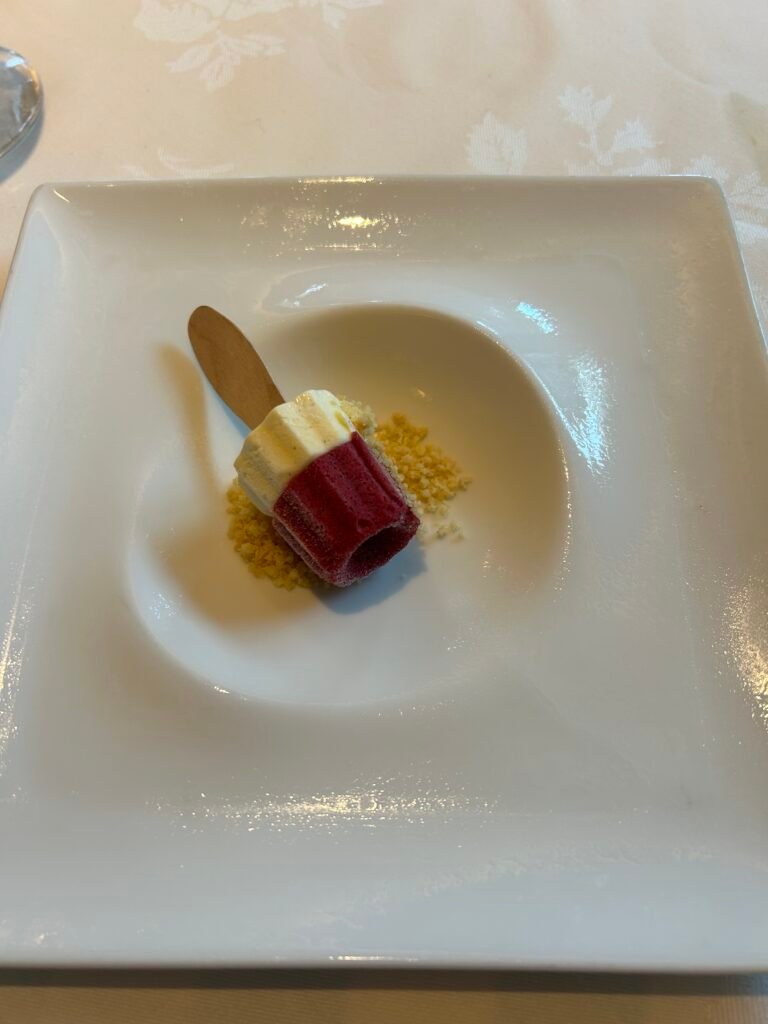
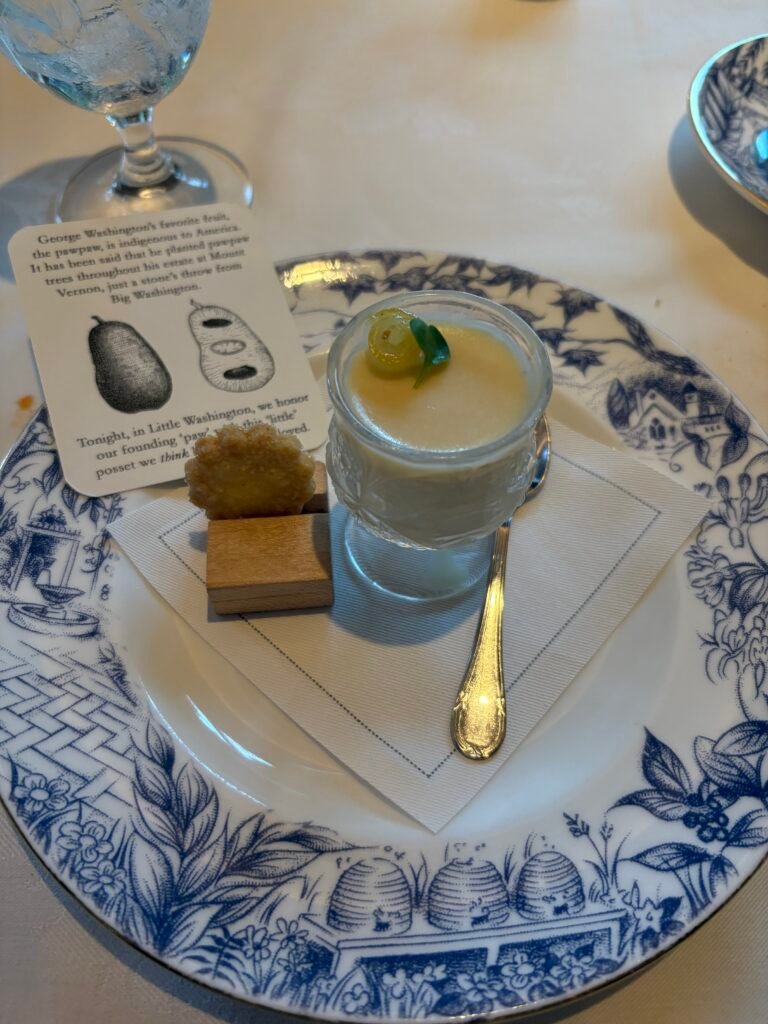
Arriving back at the table, I learned that Gerson had come around and taken responsibility for the dreamsicle mistake. It was erroneously dropped at our table and he was taking care to provide the pawpaw dish as we had wanted. I don’t know where the disconnect occurred and who was ultimately responsible, but I have to say I really respect the level of commitment to ensuring it was corrected without us needing to ask. The man was a rockstar.
The pawpaw posset dish arrived with a note with some background on the fruit and George Washington’s predilection towards it. It was custardy and sweet. It tasted like a mix of things: a banana, a mango, notes of pineapple. It was complex and unlike anything I had ever had. I was glad we got to try it. And now with the dreamsicle and the pawpaw posset behind us, consider my palate fully cleansed. An hour after ordering the desserts, they finally arrived.
At this point I should note that we’re all in various stages of full. I’m contentedly full and my mother and my sister are starting to approach their limits. But dessert is here and everyone knows there’s a second stomach for dessert. So we muster through.
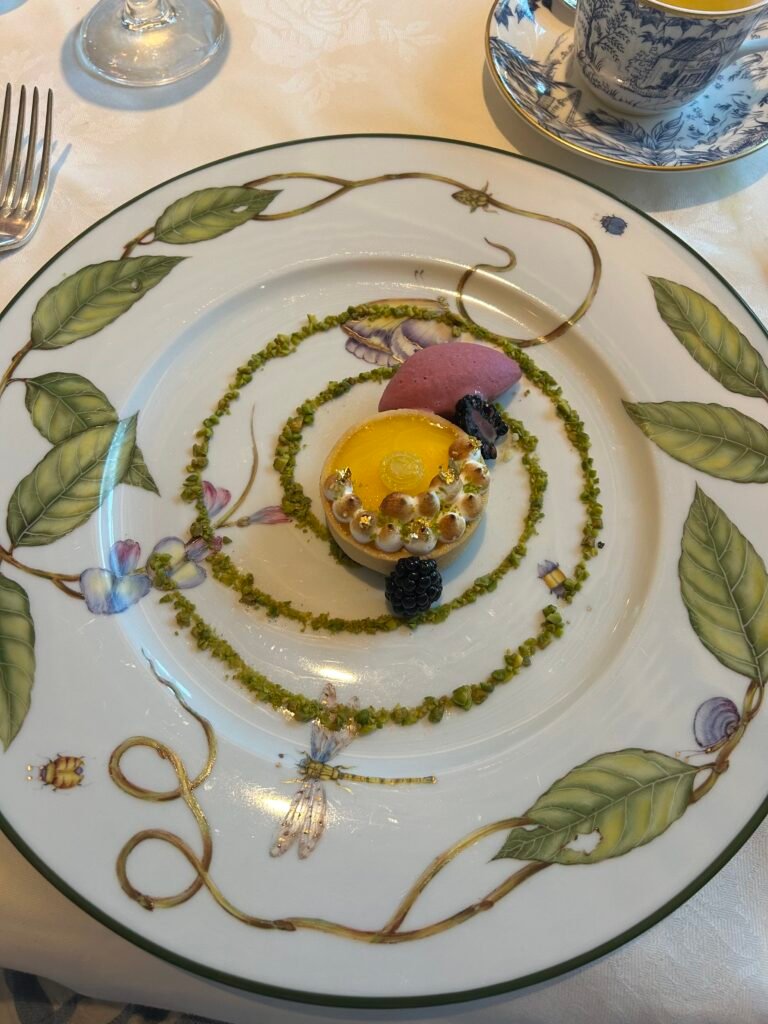
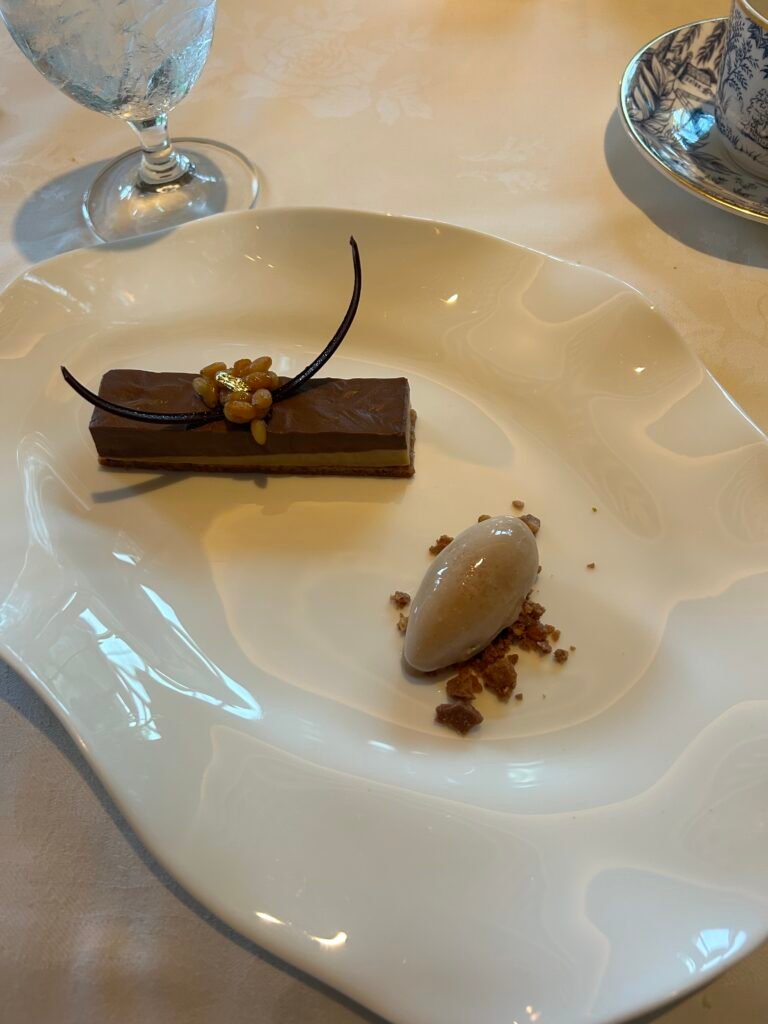
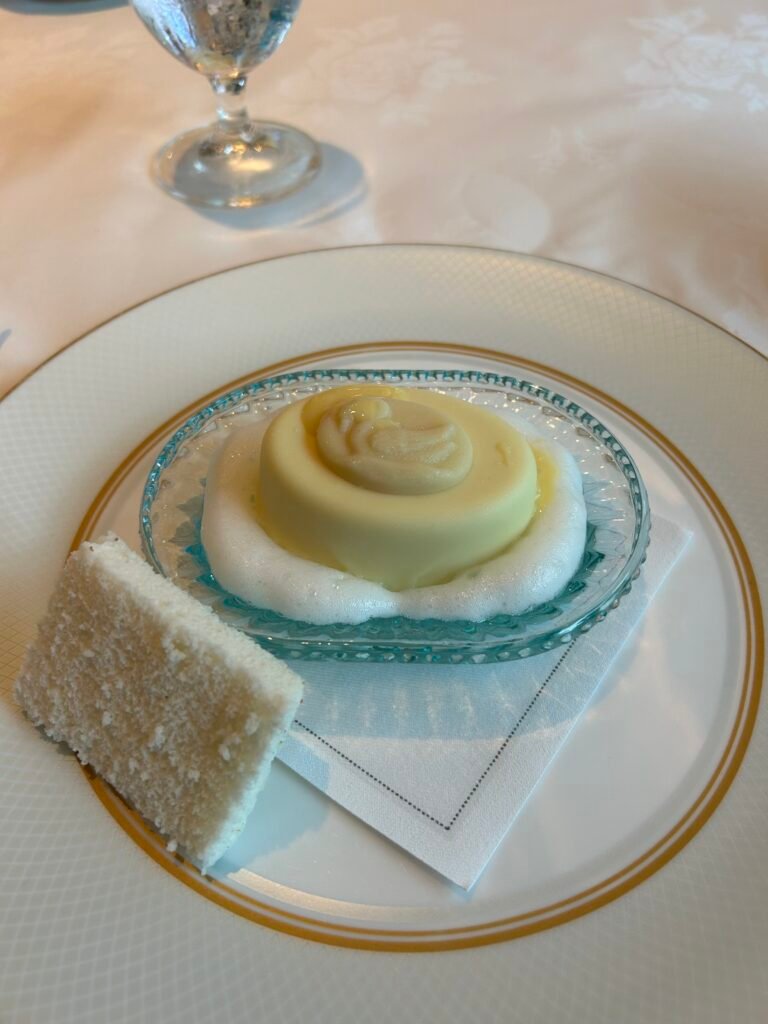
My sister got a lemon meringue tart. It was served in the middle of a spiral of crushed pistachios. A bit too tart for our liking. Easily our least favorite dessert. I ordered a chocolate and butterscotch bar with hazelnut ice cream. Tasty. Uninventive, a bit boring. The safe option from the dessert menu for sure. I was content with my choice. Boring is not always bad when it comes to dessert.
My mother on the other hand got the dish called Good Clean Fun—a coconut and passionfruit Bavarian with angel food cake. What came out was another example of “fun loving, elevated”: the Bavarian was shaped like a bar of soap with a sudsy foam and the angel food cake was shaped like a sponge off to the side. The waitress comes around with a soap dispenser and squirts on some white chocolate on to the dish. Good Clean Fun! I didn’t get too much of a taste of that dish but the presentation was lovely and exactly what a dessert should be. It was fun and inviting and seriously left an impressionable mark on my mom’s experience.
The dessert was finally behind us, and the three of us were ready to wrap up the meal and hit the road home (an exhausting two-hour drive awaited us). Dessert was the final nail in the coffin. We are stuffed. I’m still content but I don’t want any more food, dessert or otherwise. The other two are making moaning and wailing sounds that I feel are turning heads in the restaurant. Or maybe one step below that.
Gerson comes back around with what we expect to be the check. It’s not. It’s somehow more food. “Chef believes the last bite of any meal should be chocolate”, he says as he pulls out a thin sheet of dark chocolate and a mallet. He beats the chocolate into bite-sized pieces with the same intensity Gallagher affords those watermelons. We dutifully eat our last remaining bites of the meal like dogs eating scraps.
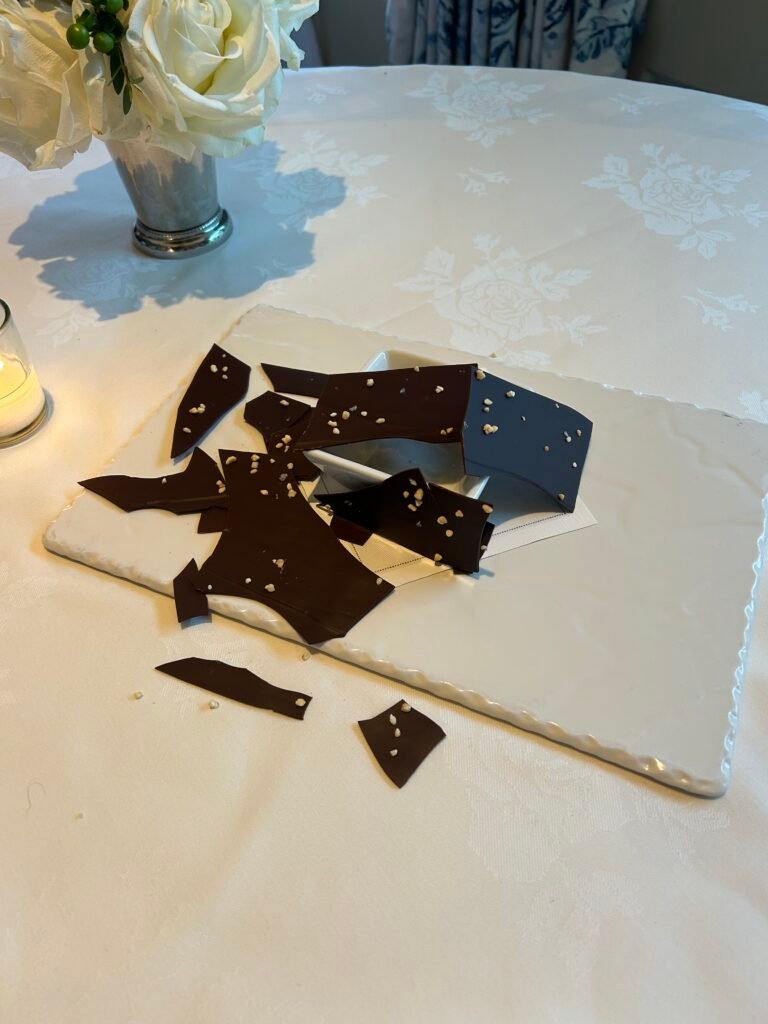
My mother and my sister are given a basket of petit fours to take home. We settle up the bill, looking forward to putting distance between us and Little Washington, and then it dawns on us: in our less hazy state of minds at the beginning of the meal we had asked Gerson if we could arrange a tour of the kitchen. To which he, of course, obliged. The preparations were being finalized, and we just needed to wait for someone to come get us.
For as full as we all were, I think we did find it in ourselves to muster up the appropriate level of appreciation for what came before us. The kitchen at The Inn at Little Washington is a sight to behold. A hallway opens up into a big, beautiful room lined with windows to let the light in—a farcry from the traditional kitchen image one would conjure in their head of a claustrophobic prison of stainless steel. There was an elegance to this room. Like it was arranged in a golden spiral orientation reminiscent of something one would find in nature: the intersection of beauty and perfection.
Standing at his post at the pass to greet us is none other than Chef Patrick O’Connell himself. His wide toothy smile meets us where we are, and we do what anyone would do in the presence of the Pope of American Cuisine: we shower him with compliments he’s probably heard a billion times before about how good his food is. He politely asks us where we’re from and makes some quick conversation before we take a picture with the man and allow him to get back to his business at hand.
One thing that strikes me walking back to my car as I work through the whole experience in my head was the persistent effortlessness of it all. Don’t get me wrong. I’ve described in excruciating detail all of the highs and the lows, but there seemed to be something majestic and magical about how it all worked together. Like a self-sustaining colony that moves as one. And having gotten to peek behind the curtain, it’s clear that we can only begin to surmise the depths a restaurant as historically successful as this one has had to go to in order to retain its sense of awe and wonder among the hundreds and thousands of guests that come through its hallowed halls. And underneath it all I’m reminded of something Chef O’Connell said in the PBS documentary: the torture and the suffering is hidden. And that’s the magic.

A food blog that doesn’t just waffle on like a soggy bottomed tart. This is bloody brilliant! The descriptions are sharp, the plating photos are stunning, and the attention to detail? Impeccable. You’ve captured the soul of fine dining—elegance, precision, and a touch of madness. Reading this felt like being in the kitchen of a Michelin-starred restaurant—intense, refined, and absolutely delicious. Keep this up and you’ll have chefs across the globe sharpening their knives in admiration. Bravo!
The best one yet!